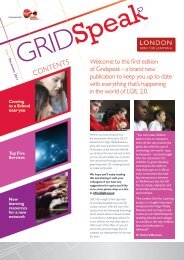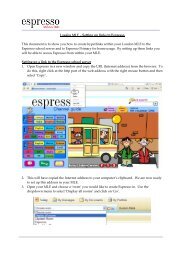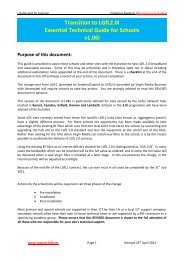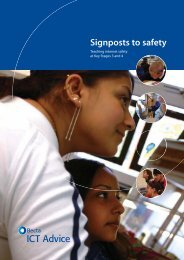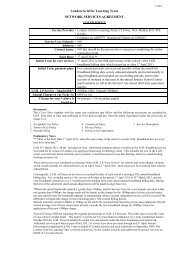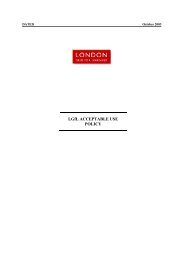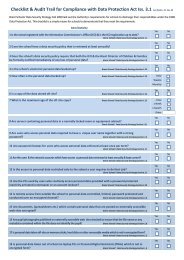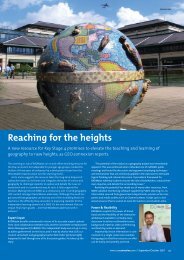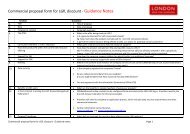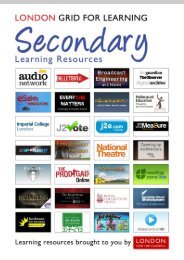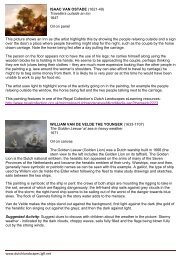Say no to bullying
Say no to bullying
Say no to bullying
Create successful ePaper yourself
Turn your PDF publications into a flip-book with our unique Google optimized e-Paper software.
Blue set resource sheet: Year 2Sean and LisaPart 1Read the s<strong>to</strong>ry Sean and Lisa at the end of this section, <strong>to</strong> the end of Part 1.Ask the children if they think that Sean and Lisa are being bullied. Why do theythink so? (Refer <strong>to</strong> the three key questions <strong>to</strong> decide if it is <strong>bullying</strong> –ongoing/deliberate/one person stronger or more powerful.)What sort of <strong>bullying</strong> is happening <strong>to</strong> Sean and Lisa? (Sean: physical hurting;taking his money; damaging his things. Lisa: put-downs; making fun; leaving herout/excluding her; saying nasty, untrue things.) Scribe the answers.We asked a groupof children <strong>to</strong> ‘ac<strong>to</strong>ut’ the s<strong>to</strong>ry whileI read it out. Weused props <strong>to</strong>remind the childrenwho was who.Ask the children ‘Which is the worst sort of <strong>bullying</strong>?’ ‘What is happening <strong>to</strong>Sean’, ‘What is happening <strong>to</strong> Lisa?’ How do they k<strong>no</strong>w? This activity could bedone by listing the types of <strong>bullying</strong> which children come up with and askingthem, in pairs, <strong>to</strong> rate or order them according <strong>to</strong> how bad they think each is.Alternatively, the children could be given cards with types of <strong>bullying</strong> on and beasked <strong>to</strong> physically order the cards. They should then explain why they haveordered them as they have.Emphasise that the only way of k<strong>no</strong>wing how bad <strong>bullying</strong> is, is <strong>to</strong> k<strong>no</strong>w how itfeels <strong>to</strong> be on the receiving end. All forms of <strong>bullying</strong> can have an equally hurtfuleffect.Ask ‘Who is involved in the <strong>bullying</strong>?’ (The children doing the <strong>bullying</strong>, the childrenwho are bullied, the watchers or witnesses.)Ask the children <strong>to</strong> think about how Sean and Lisa are feeling. Divide the childrenin<strong>to</strong> three groups. Explain that in this activity <strong>no</strong> one can talk or make a <strong>no</strong>ise,and <strong>no</strong> one is allowed <strong>to</strong> <strong>to</strong>uch a<strong>no</strong>ther child. (If possible, use the hall orplayground for this activity.)Ask one group <strong>to</strong> walk around the room as either Sean or Lisa – showing withtheir bodies and their faces how they might look at playtime.Ask a<strong>no</strong>ther group of the children <strong>to</strong> pretend <strong>to</strong> be Jordan and his friend, orAmena or one of her friends going out <strong>to</strong> play, and <strong>to</strong> use their body and face <strong>to</strong>show what they are feeling and thinking. How will they look when they see a‘Sean’ or a ‘Lisa’?Ask the final group <strong>to</strong> join the others – they are the ‘watchers’ or ‘witnesses’.What would they be doing? How would they be feeling?After 2 minutes change the groupings, and after a<strong>no</strong>ther 2 minutes change oncemore, so all children have an opportunity <strong>to</strong> be in each role.Discuss the activity. The following questions can be used as prompts:• Was it easy <strong>to</strong> tell which group children were in? How did the ‘powerfulchildren’ show their power?• What do you think the feelings of each group might have been?23© Crown copyright 2005 <strong>Say</strong> <strong>no</strong> <strong>to</strong> <strong>bullying</strong> Years 1 and 2DfES 1340-2005Primary National Strategy



